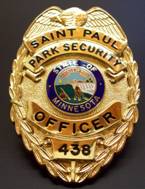Walking and Jogging Safety
• Be aware of your surroundings at all times.
• Walk/jog confidently.
• Don't wear headphones while exercising so that you can hear your surroundings.
• Wear shoes and clothing that allow freedom of movement.
• Carry a cell phone in case of emergency.
• Carry a whistle with you.
• Walk or jog in a familiar area. Avoid secluded areas where there are places to hide.
• Vary the route you take and change up your routine. Do not take the same route every day.
• Walk or jog with a companion or a pet, especially at night.
• Wear bright colored clothing so that you can easily be seen; at night, wear reflective clothing.
• Walk or jog facing traffic.
• Lock your vehicle. Don't leave valuables, such as purses/wallets/cell phones, visible inside.
• Always let someone know when you begin your walk or jog. Let them know about the route you will be taking and when you plan to return. Inform them when you do return.
Bicycle Safety
- Wear proper safety equipment (i.e., helmet).
- See and be seen by wearing highly visible clothing.
- Avoid bicycling at night. If you ride at night, lights and reflectors are required. In addition, wear reflective clothing.
- Stay alert. Expect the unexpected.
- Exercise caution and constantly be aware of the traffic around you.
- Obey all traffic laws and/or trail rules.
- Always make sure your bicycle is in good working condition.
Trail Etiquette, Rules and Regulations
- Cyclists should ride in a single file line to the far right of the trail at a speed that is reasonable and prudent.
- Exercise due care and sound a warning when passing others.
- No more than two pedestrians should walk side-by-side. Pedestrians shall remain on the far right side of the trail.
- Dogs and other pets must be kept on a leash and reigned into within four feet when approaching another person. Feces must be properly disposed of.
- No motorized vehicles are allowed on any trail.
- Prohibited activities include: camping, trapping, horseback riding, hunting, advertising, and soliciting.
- Use authorized trails, and respect closures. Minimize trail erosion by avoiding muddy trails.
- Do not litter.
Swimming Safety
The following are general guidelines. Saint Paul's pools and beaches have specific rules and regulations that are posted at each facility.
- Only swim in designated swimming areas.
- Be aware of local weather forecasts and conditions.
- Make sure the water is warm enough. Children and certain adults are at risk of developing hypothermia at much faster rates.
- Use only U.S. Coast Guard approved lifesaving devices where applicable and allowed.
- Do not rely upon inflatable devises such as water wings, floaties, balls, or vests as lifesaving devices.
- Do not assume that children who have taken swimming lessons will be safe in the water. Do not leave children unsupervised.
- Be aware of changes in a person's physical condition, such as being too cold, appearing too tired, getting to much sun, and engaging in too much strenuous activity to the point of exhaustion.
- Watch for signs of heat exhaustion and heat stroke.
- Do not consume alcohol while swimming and do not swim after drinking.
- Drink plenty of water, and limit your time in the sun between 10 a.m. and 4 p.m.
See Park Rules and Regulations regarding swimming.
Ice Skating and Ice Fishing Criteria for Designated City Lakes
A minimum of four inches of solid surface ice is recommended before foot traffic on City lakes is attempted. Ice fishing is not allowed in areas designated for ice skating. Ice fishing holes on City lakes cannot exceed 10 inches in diameter.
Many factors affect ice quality. Ice is both subject to variable freezing temperatures from above and constant thawing temperatures from below due to water temperatures in the 40-degree Fahrenheit range. Wind-whipped water, areas of water that move due to either overland runoff or underground springs, as well as shaded or sunny areas, all lead to freezing and thawing conditions. Snow is another contributing problem, as snow cover acts as an insulator. Ice may actually begin to melt despite freezing temperatures.
Remember that even when conditions are determined to meet the criteria for skating or fishing, never do these activities alone and never gather in large groups on one spot. It is a good idea to have a rope, ladder, or pole available that could be extended to a victim in an emergency. Hypothermia, the rapid cooling of a person's body, can result in death. When it comes to ice, please remember one rule: there is no such thing as safe ice. See Park Rules and Regulations regarding ice fishing.
Ice Skating/Fishing Safety
Obey all postings in regards to ice safety. Ice should be at least four inches thick before venturing out onto City lakes. Please follow these safety tips.
- Skate/Fish at your own risk.
- Ice thickness is not consistent throughout. Water currents, particularly around narrow spots, bridges, inlets, and outlets are always suspect when it comes to thin ice.
- Never skate/fish alone. Always have at least two people present.
- Children should never be allowed to skate/fish on a pond unsupervised.
- Beware of ice around partially submerged objects, such as trees, logs, brush, embankments, or dam structures.
- Do not congregate in one area.
- Stay away from cracks, seams, pressure ridges, slushy areas, and darker areas that signify thinning ice.
Sledding Safety Tips
- View a list of Saint Paul Sledding Hills.
- Inspect the sledding course for hazards. Trees, fences, rocks, and telephone poles may cause injuries. Hay or straw bales may not always protect from injuries.
- Make sure that the bottom of the hill is long enough for the sled to stop safely.
- Select age-appropriate sized hills, avoiding steep inclines for small children.
- Never sled near traffic, roads, parking lots, rivers, or bodies of water.
- Never sled alone. Small children should always be accompanied by an adult.
- Insist that children wear bicycle helmets when sledding.
- Use the proper equipment. Do not use sheets of metal, pieces of wood, etc., for sleds.
- Use equipment properly. Don't stand or put more people on the sled than what it was intended for.
- If an adult rides on a sled with a child, the adult should sit with the child seated snugly in front between the adult's legs.
- Avoid sledding over snow bumps or anything that may cause the sled to become airborne.
- Only sled during daylight hours.
- Do not sled on icy hills. Sledding hills should be only snow covered.
- Stay alert and keep your eyes open. Use common sense.
- Walk off to the side when going back up a hill, and stay away from oncoming sleds.
- Dress appropriately.
Bonfire Safety
- Bonfires on park property are allowed only in designated fire rings and certain requirements must be met.

